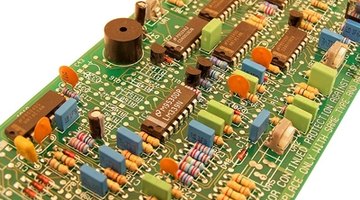How to Calculate Resistance From Hz
The dynamic resistance of an AC circuit is described by the term impedance, for which ohms is also the unit of measure. This impedance in AC circuits is caused by the reluctance of the inductor, which is the wound magnetic coil within the circuit, to pass current above a certain predefined frequency, as the magnetic field generated by the inductor acts as canceling momentum upon itself. As a result, this dynamic resistance increases to a point where current can no longer flow through the inductor, despite the voltage being applied to it.

-
Define the resistance from Hertz, or Hz, application. In this example, a standard inductive coil in a nonreactive industrial power control system application normally passes 800-watts of power at 240-volts AC and 60 Hz. If a researcher wants to use the same coil to limit current flow at 120 Hz, or twice the frequency, you can calculate the new dynamic resistance or impedance value of the coil, and the amount of power it allows to pass.
-
Calculate the current in amperes, or amps, flowing when the frequency is 60 Hz. For nonreactive loads, power in watts = volts * amps and therefore, amps = watts/volts. Substituting stated values, current in amps = 800 watts/240 volts = 3.333 amps. Since the inductor formula is X(inductor) = V volts/I amps, then X(inductor) = 240/3.333 = 72 ohms.
-
Determine the inductor's value in Henries (H) and millihenries (mH). Since X(inductor) = w(angular frequency in radians/sec) * L(inductance in millihenries), then L = X/w where w = 2 * pi * frequency (Hz) or 2 * 3.1416 * 60 hz = 377 radians/second. Substituting calculated values, L = 72 ohms/377 radians/sec = 0.191 Henries or 191 millihenries.
-
Calculate the new value of X if frequency is doubled to 120 Hz. This effectively doubles the value of w in radians/second from 377 to 754. Now X = 754 radians/second * 0.191 Henries = 144 ohms of impedance.
-
Calculate resistance from the new value of impedance, 144 ohms. Because the load is nonreactive, resistance R in ohms = X = 144 ohms at the higher frequency.
-
Calculate the new value of power in watts at the higher frequency by solving I = V/X, = 240 volts/144 ohms = 1.667 amps. Power = V * I or 240 * 1.667 or 400 watts of power that will be passed by the inductor.


References
Resources
Tips
- Check the DC resistance of an inductor first to see if it will overheat with lower frequencies.
Warnings
- Some inductors will overheat and burn out or cause fires when used with DC currents.
Writer Bio
Pauline Gill is a retired teacher with more than 25 years of experience teaching English to high school students. She holds a bachelor's degree in language arts and a Master of Education degree. Gill is also an award-winning fiction author.
Photo Credits
- transformer image by palms from Fotolia.com
- circuit board image by dwags from Fotolia.com
- power supply image by pmphoto from Fotolia.com
More Articles



